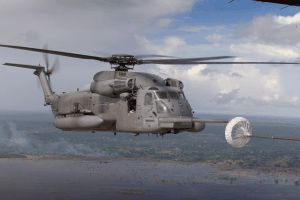 The unit requesting aeromedical evacuation
support is responsible for selecting and properly marking the helicopter
landing zones. The unit requesting aeromedical evacuation
support is responsible for selecting and properly marking the helicopter
landing zones.
Essential requirements for a landing zone are:
- LZ and approach should be free of obstructions.
- Sufficient space should be available for hovering and maneuvering.
- Minimum size of the LZ varies with the particular helicopter,
temperature, weather, altitude, terrain, and loading.
- For light helicopters, under typical conditions, a minimum LZ would
be 30 meters in diameter with an approach and departure clear of
obstructions.
Loose objects must be removed from the LZ (ponchos, cartons,
tents, etc) as they will be blown around by wind from the main rotor.
Obstacles (antennaes, cables, wires, etc.) should be removed from the LZ
and approaches. If conditions do not allow for removal of all obstacles,
mark them so they are clearly visible to the pilot. At night, red lights
are used to mark obstacles. If the tactical situation does not allow for
such lighting, notify the pilot of the existing hazard by radio.
Identify the LZ, when possible, with a large letter "H" or
"Y." If using improvised LZ markers, stake them into the
ground firmly. Placing rocks at the edges is usually not enough to keep
the ground panel markers from being blown away in the rotor wash.
At night, use chemical lights in each of the 4 corners of the LZ. Don't
use flare pots or other open flames as they will usually be blown out by
the rotor wash. If you have no other option, notify the pilot of the
burning materials, keep them more than 3 meters from where the helicopter
will land or hover, and secure them so they won't blow over.
If all you have at night is a flashlight, stand with your back to the
wind, just beyond the edge of the LZ, and point the flashlight back over
the LZ, bisecting it in half. The pilot will follow your your flashlight
and set the helicopter down in the center of the beam, at the center of
the LZ. Keep the flashlight low to the ground and don't point the beam in
the pilot's eyes.
Indicate the wind direction:
- Ignite a smoke grenade when the helicopter is in sight and have the
aircrew visually identify the color.
- Place a rag or windsock on a stake near the edge of the LZ.
- Have one person stand at the edge of the LZ with his back to the
wind and one arm pointing straight out in the direction of the wind.
After the helicopter lands:
- Follow the directions of the aircrew EXACTLY.
- Approach the helicopter at a 45 degree angle from the front, so you
are in clear sight of the pilot and aircrew.
- Keep as low to the ground as you can. Rotor blades occasionally dip
down and can strike you if you are standing straight up.
- If the helicopter is on a slope, it is better to approach it from
the downhill side.
- Smoking is not permitted within 50 feet of the aircraft.
- Remove your field cap and place it securely in a pocket so it
doesn't get blown off in the rotor wash.
- Use hearing protection if available.
Approved for public release; Distribution is unlimited.
The listing of any non-Federal product in this CD is not an
endorsement of the product itself, but simply an acknowledgement of the source.
Operational Medicine 2001
Health Care in Military Settings
Bureau of Medicine and Surgery
Department of the Navy
2300 E Street NW
Washington, D.C
20372-5300 |
Operational Medicine
Health Care in Military Settings
CAPT Michael John Hughey, MC, USNR
NAVMED P-5139
January 1, 2001 |
United States Special Operations Command
7701 Tampa Point Blvd.
MacDill AFB, Florida
33621-5323 |
This web version is provided by
The Brookside Associates Medical Education Division.
It contains original contents from the official US Navy NAVMED P-5139, but has
been reformatted for web access and includes advertising and links that were not
present in the original version. This web version has not been approved by the
Department of the Navy or the Department of Defense. The presence of any
advertising on these pages does not constitute an endorsement of that product or
service by either the US Department of Defense or the Brookside Associates. The
Brookside Associates is a private organization, not affiliated with the United
States Department of Defense.
Contact Us · · Other Brookside
Products
|
 The unit requesting aeromedical evacuation
support is responsible for selecting and properly marking the helicopter
landing zones.
The unit requesting aeromedical evacuation
support is responsible for selecting and properly marking the helicopter
landing zones.